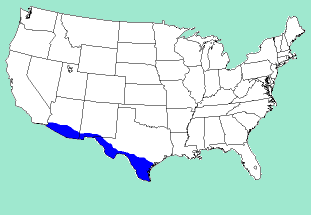Descriptive Qualities:
Range
The Calleta moth's range is very limited. They are in southeast Texas and southern Arizona.
Map of this moth's Area:

Eggs and Larva
Depending on the particular size of the moth, female Calleta moths have approximately 250 - 350 eggs. Calleta's have one brood in all of their area.
Scenting and Mating
Female Calletas usually put their scent out from 12AM to dawn. The males may come in at any time during this period. It is easiest to put the female in a metal cage with holes big enough that they can mate through it (about a half inch or 3/4 inch hole should do nicely) but small enough that the female cannot escape. That is the best way to do it if you don't have the luxury of staying up all night to watch them. I usually stay up and wait for the males to come in, and then put them with the female. This way is the only real way to tell how many came in.
Cocoons
Personal Markings or Characteristics
The Calleta moth is a very dark moth, like the male Promethea. It has small triangles of white on each wing.
Caring For Calletas, In All Stages:
Here are some notes that may be helpful when trying to raise Calleta larva, especially if it's your first time raising them.Caring for the eggs
To care for Calleta eggs, just put them in a small container. It is best to be small, because the larva like to crawl a lot when they first hatch, and if you put them in a bigger container, they will crawl away from the food you put in with them, and might not be able to get back. That's a lot of area for such a small caterpillar.
Food Plants
Here is a list of all food plants that I have ever used to raise Calletas on. In the odd occurance that you can not come by any of these, you should contact me.
Raising Calleta Larva (Inside)
Calleta are easily raised inside. Just put them in a container with their food host, and keep the food fresh.
Raising Calleta Larva (Outside)
Raising Calleta outside may prove difficult, unless you have the ideal conditions. They don't like high or low temperatures, or high humidity.
Caring for the cocoons
Caring for Calleta cocoons is pretty simple. You should put them in an area where it is cool and somewhat dry. Since they come from a hot climate, you do not want to keep them outside if you're located in a colder climate. You want to keep them in the house or basement, at about room temperature. You do NOT want to keep them in the fridge for the winter! As summer approaches, put them in the fridge for 2 weeks and then remove them and put them out in the 70 or 80 degree weather.. misting occasionally. They should hatch within 1 month.
Click here to return to the Index
Comments and suggestions are welcome, send them to me at: [email protected]